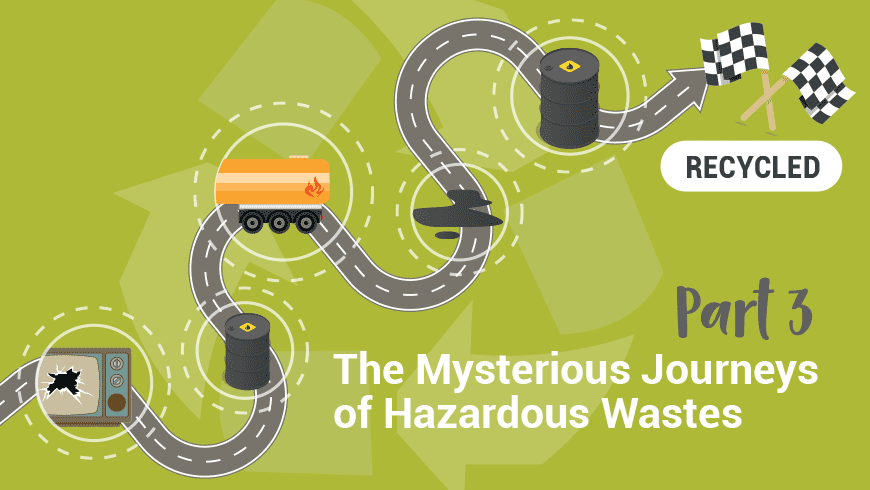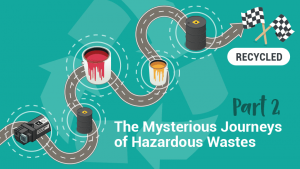After the positive feedback we received for the Mysterious Journeys of Hazardous Waste Part One and Part Two, we are very pleased to return with the third installation of this journey, and oh what a journey it has been so far!
Already we have covered all of these hazardous waste items:
From the list of waste items that we know to be dangerous or toxic, or that pose a significant threat to our waste operatives, we are explaining what happens to them once their usefulness has expired. This list is often pinned to the wall, or can be found on the websites of almost every business in the waste management, skip hire and environmental services sectors. It was decided upon by the government and has proved beneficial to us and our competitors, protecting us to some extent.
In this article, we will be covering the after-life process of chemicals and old TV sets…
But before we approach these items, we’d like to give you a friendly public service announcement…
Old e-waste and your unwanted electronics
We’ve covered culture and mentality in recent months, addressing the throwaway culture, the growing popularity of refurbishing electronics, designed obsoletion and data destruction.
The thing that connects all of these ideas, is GDPR. On May 25th, just a few weeks ago, the world changed, hopefully for the better. Global Data Protection Regulations are designed to put the power and ownership of personal data back in the hands of digital citizens. What this means, is that you are now responsible for your own mess, in a sense.
- If you are going to throw away electronics, you MUST take the time to erase all of your personal data, or you could end up in a difficult position.
- If you enjoy refurbishing electronics, be careful to wipe any data storage devices that come into your possession. The same goes for if you buy refurbished devices – be sure that whoever you purchase from has properly erased the data.
- Read our guide on data destruction here to understand why we use the same software as all of the world’s top security agencies.
Remember, GDPR is a good thing, but it will adjust our digital habits and activities.
Old TV sets
Talk to almost any waste management or recycling company and it’s likely they’ll sigh, tut, or express some kind of frustration with the after-life of old TV sets. These pesky items come with several problems, such as:
- They contain 2-4 kg of toxic substances, including lead, cadmium, mercury and arsenic
- They are difficult to disassemble
- There is little opportunity to profit from the components
- The old materials often can’t be reused either
- Throwing them in the landfill does even more environmental damage
Why are old TVs such a common waste?
Let’s look back to the Autumn of 2012 when the UK finished its transition from analogue to digital television. As soon as this change had taken place, millions of old TV sets immediately became redundant. Local news and sustainability websites urged people not to send perfectly functioning TVs to the landfill, but it didn’t really stem the flow. It’s a sad truth that a large percentage of TVs now sit in landfills, recycling centres and tips, even though they didn’t really have much wrong with them.
Many local councils created literature that explained people’s options, mostly informing them that they should take their TVs to their local recycling centre. What we believe they should have done, is to prioritise reuse, and push the agenda of digital conversion boxes, a simple and effective solution that meant most old TVs could continue bringing joy to living rooms around the country.
What can be done?
If like Enviro Waste, you are hell-bent on making sure that if something can be reused or recycled, then it is, you will be glad to know that we are avoiding the landfill where possible. For old TV sets, we have forged unique partnerships with specialist recyclers to make sure that materials, whether toxic or not, can be recovered and recycled from these units.
This means that when we recycle an old TV:
- We can recover wood, plastic, and metal from the frame and casing
- We can recover glass from the screen
- We can recover precious metals like copper, gold, silver and platinum
- We can recover mercury from LCD screens for recycling
- We can safely separate leaded and unleaded gases from CRTs
The plastics and frame metal are baled and sold into the recycling industry, as is the glass, which is crushed and sold. The precious metals from the operating system are carefully extracted, collected, and then sold to traders. LCD screens are dismantled carefully and each component is extracted to be recycled and sold.
CRT recycling is the tricky one!
When we think of an old television, it probably looks something like the image below. Cathode Ray Tubes are the technology behind these old units, giving light to the screens. Their recycling journey is more mysterious than the other materials, especially as these CRTs contain nasty chemicals that are poisonous to humans.

A CRT recycling plant employs an electrically charged hot wire band that is placed around the screen to separate the funnel (the lead glass) from the panel (the clear glass). The phosphor powder is removed from the panel by way of a vacuum and is sent for the recovery of rare earth elements. The funnel glass is then sent for further treatment to separate and recover the lead metal.
During the lead recycling process, the funnel glass tube is placed face down on a turntable while a laser cutter chops part-way through its thickness. The process takes up to 90 seconds, but if you consider that more than 50% of an old TV is CRTs, and around 65% of these CRTs are made up of lead, there is a considerable amount of work to be done!
Chemicals
When it comes to chemical recycling, these are the questions to ask, over and over again, to avoid harming people or the environment:
- what chemical is it?
- how toxic is it?
- how much of it is there?
- what format is it in right now?
- is it flammable?
- have the risks of cross-contamination been eliminated
The first stage is to extract the chemicals from the current site
To do that, you need to know what form they are in – are they liquid, sludge, slurry, solid, gas, acids, solvents, drummed or packaged, to give a few examples.
- For large amounts of sludges, solvents, acids, or pretty much any liquid or gas chemical waste, it’s quite common to employ a tanker to do the removal job.
- For drums and packaged chemical waste, trucks and curtain-siders can do the job very well.
- For small amounts of chemical waste (like batteries or light bulbs), there are often collection box services available from waste companies.
There are so many chemicals out there that it is impossible for us to sift through which ones can and can’t be recycled, but to give you a good idea, here are a few common ones that Enviro Waste are making sure get recycled:
- Coolants – The antifreeze chemical inside radiators is made of ethylene glycol, lead, cadmium and chromium. This one is quite easy to recycle and can be done with one commercially purchased machine for your business, or by using a specialist recycling company who can recycle it and even resupply it back to you. The process removes the heavy metals and oils, and introduces new chemicals that stop the ethylene glycol from breaking down.
- Ink, Oil and Paint – Covered in Part Two of the mysterious journeys of hazardous waste series.
- Chemical Drums – Whilst not a chemical themselves, chemical drums carry and transport the chemicals, and so they are inherently contaminated. Luckily for them, since they are made from steel and plastics, they are quite easy to recycle. By law, some chemical drums, depending on what they contained, must be washed thoroughly and used again for the same purpose. It’s commonplace for non-toxic drums to be washed and refurbished, replacing lids and fixing any dents, before being resold into the industry. The third instance, recycling, takes place after a triple-rinse, puncture and crushing process. The scrap metal can be sold for reprocessing.
Not recycled:
- Pesticides
- Fungicides
- Herbicides
- Agricultural antibiotics
- Fertilisers
- Pool chemicals
Conclusion
Hard to recycle does not always mean impossible to recycle, as we’ve proved from exploring the mysterious journeys of all of these different hazardous wastes in this in-depth content series. In part four of the mysterious journeys of hazardous waste, we will be looking at some more tricky materials.
We encourage you to be curious, inquisitive and creative in pursuit of zero-to-landfill policies, landfill diversion strategies and opportunities to practice the 5 Rs – reduce, reuse, recycle, refuse, and refurbish.


